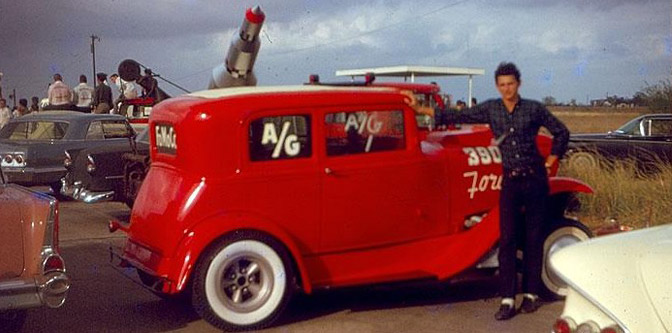Three Ninety Vicky

A Rocket. A Vicky. A/Gas. A what? A/Gas? No, the first part—the Rocket. What is it doing there? Better question, what is any of this stuff doing there, under the cover of feathered clouds and splotches of blue sky on a Saturday afternoon? At first glimpse, the scene looks painted—a landscape slipping further into the surreal as the horizon extends. The wind picks up.
A young man, tall and slim, rests his hand on the roof of a car—his car. He’s spent years building this machine. It’s a little older than he is. It was created Up North near the River Rouge. The car looks far different than it did then, now that it is far away from its point of origin. From nose to tail, things have changed. Take a look.
Up front, the car sits higher (and looks stouter) with a rebuilt spring. That’s for improved weight transfer. The wishbone has been split, and the car sports wide whitewall tires complete with spun aluminum wheel discs. An added bonus of the raised front end is that it provides extra room for those massive collectors coming off the tube headers. If it weren’t for the owner’s unsalable sense of Blue Oval pride, we would have a tough time figuring out what mill lies beneath the custom-formed hood. Thanks to the bold, Playbill-style lettering, there’s no doubt that it’s powered by a three hundred and ninety cubic inch Ford—An FE. The induction, however, remains a mystery. FoMoCo, the back window boasts, FoMoCo. All that Dearborn horsepower is transferred to a set of American Racing five spokes (in an early state of oxidation) and a pair of piecrust whitewall slicks. The clouds continue to roll in.
This red lacquered Vicky has the quintessential early sixties look, and the tall Texan posing proudly beside it knows that for a fact. There’s a hint of street, a dash of show and a strong helping of strip. Dig the details like the single standard taillight, white top insert and hand-formed rear nerf setup. It’s spot on.
I have had this image from November 1963 stashed away for several years, collecting a great deal of digital dust, as they tend to do so often. After some digging, I discovered that the man behind the camera was Donald Goldman. Goldman shot this photo, along with dozens of others, at Six Flags Drag Way in Victoria, Texas. The strip, which operated from 1963 until 1975, was located on the Aloe Air Field. We have a sense of time and a sense of place—and maybe we’re one step closer to figuring out why there’s that rocket in the background.
—Joey Ukrop
Photo from the H.A.M.B., originally shot by Donald Goldman, November 1963. With any luck, we’ll have more on Six Flags Drag Way in the near future.




